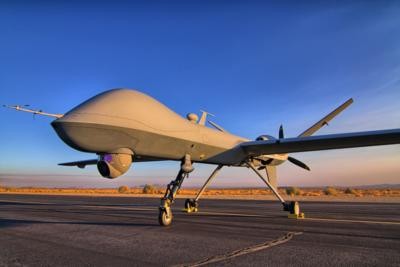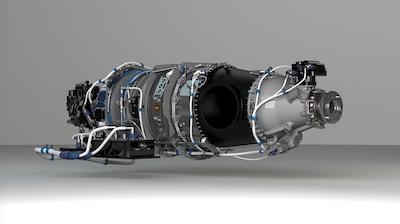Thu, Aug 18, 2022
Don’t Fear the Civilian Reaper
General Atomics Aeronautical Systems, the California-based energy and defense concern, has undertaken testing of Pratt and Whitney’s PT6 E power-plant on its MQ-9B SkyGuardian Remotely Piloted Aircraft (RPA). The tests, which consisted of multiple full-power runs, were performed at General Atomics’s Desert Horizon flight operations facility in El Mirage, Calif.

The MQ-9B SkyGuardian derives of the combat-proven MQ-9 Reaper in use with the United States Air Force, Navy, and numerous NATO militaries. SkyGuardian—unlike its warfighter sibling—was developed in accordance with EASA regulations for purpose of boosting European sales of the critter.
The MQ-9B SkyGuardian features electro-optical/infrared sensors, de/anti-icing systems, TCAS, and automatic takeoff and landing capability. The vehicle is operated by means of a redesigned & modernized ground control station with four crew-terminals. SkyGuardian is designed to fly Beyond Visual Line of Sight (BVLOS) via SATCOM for up to forty-hours. The MQ-9B is certified for all-weather flight and—by virtue of its compliance with NATO STANAG (Standardization Agreement) 4671—integrates smoothly and safely into civil airspace, thereby enabling joint-force-military and civilian authorities to benefit from real-time situational awareness of events ostensibly germane to national security.
General Atomics Aeronautical Systems president David R. Alexander states: “We’ve enjoyed a long-term relationship with Pratt & Whitney. Integrating their PT6 E-Series engine onto our MQ-9B SkyGuardian aircraft offers an alternate option for future customers that includes a 33-percent increase in power, dual channel electronic propeller, and engine control system, as well as all the benefits of the PT6 engine family.”

Pratt & Whitney Military Engines president Jill Albertelli adds: “Our PT6 E-series is the ideal engine for this mission, and we look forward to working with General Atomics on this important program.”
Since entering service in 1964, Pratt and Whitney’s PT6 engine family has logged more than 400-million flight hours. Renowned for an in-flight shutdown rate of only 1 per 651,126-hours—the remarkably reliable power-plant has been produced in variants ranging from 580 to 1,940-shaft-horsepower.
More News
Terminal Radar Service Area Airspace surrounding designated airports wherein ATC provides radar vectoring, sequencing, and separation on a full-time basis for all IFR and participa>[...]
Aero Linx: Utah Back Country Pilots Association (UBCP) Through the sharing experiences, the UBCP has built upon a foundation of safe operating practices in some of the most challen>[...]
From 2010 (YouTube Edition): Imagine... Be The Change... Inspire FROM 2010: One of the more unusual phone calls I have ever received occurred a few years ago... from Anousheh Ansar>[...]
(Pilot) Felt A Shudder And Heard The Engine Sounding Differently, Followed By The Engine Chip Detector Light On April 14, 2025, about 1800 Pacific daylight time, a Bell 206B, N1667>[...]
Also: AMA Names Tyler Dobbs, More Falcon 9 Ops, Firefly Launch Unsuccessful, Autonomous F-16s The Air Force has begun ground testing a future uncrewed jet design in a milestone tow>[...]
 ANN's Daily Aero-Term (05.07.25): Terminal Radar Service Area
ANN's Daily Aero-Term (05.07.25): Terminal Radar Service Area ANN's Daily Aero-Linx (05.07.25)
ANN's Daily Aero-Linx (05.07.25) Classic Aero-TV: Anousheh Ansari -- The Woman Behind The Prize
Classic Aero-TV: Anousheh Ansari -- The Woman Behind The Prize NTSB Prelim: Bell 206B
NTSB Prelim: Bell 206B Airborne-NextGen 05.06.25: AF Uncrewed Fighters, Drones v Planes, Joby Crew Test
Airborne-NextGen 05.06.25: AF Uncrewed Fighters, Drones v Planes, Joby Crew Test




